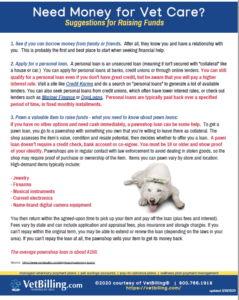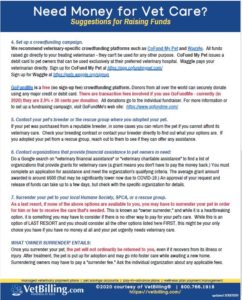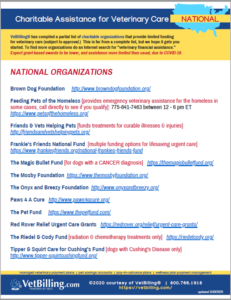We hear from literally thousands of pet owners each month who are looking for veterinarians that offer in-house installment payment plans, because they can’t afford the upfront cost of veterinary care. Many of these pet owners don’t qualify for the credit-based options that most veterinarians offer (CareCredit, Scratchpay, WellsFargo, etc.), and they are desperately looking for an alternative. Unfortunately, there are very few veterinarians who offer non-credit-based payment plans anymore. And here is the unvarnished truth about why that is:
Too many pet owners failed to honor their payment obligations when they agreed to a payment plan, and veterinarians lost money as a result.

Don’t wait until your pet is ill or injured to think about having an action plan to pay for emergency veterinary care.
After experiencing this time and again, many veterinarians simply decided that they could no longer afford to take on this financial risk. While veterinary care is expensive for pet owners, veterinary practices typically aren’t high profit margin businesses – they have signficant overhead. Unlike human doctors, they offer many services under one roof: radiology; dentistry; surgery; labwork; imaging; pharmacy. It is expensive for them to offer all these services, and on top of that, they have to cover salaries and wages for doctors and support staff: veterinary technicians and assistants, client service representatives, kennel assistants, and business managers.
What can you, as a pet owner, do to increase the odds that a veterinarian will work with you when you have budget constraints?
1) Have an established relationship with a veterinary practice.
Please don’t wait until your pet is sick or injured to establish contact with a veterinarian! We can’t emphasize this enough. When you first acquire a puppy or kitten, it may be hard to imagine that something could go seriously wrong – but pets are a lot like children. They get into things they shouldn’t, they play hard and get injured, and they are vulnerable to illness. At the very least, you should be seeing a veterinarian to make sure your pet is properly vaccinated and receiving appropriate preventive care. When you have a relationship with a veterinary practice, you are establishing trust. If the veterinarian knows you and your animal, they will be more willing to work with you in times of hardship.
2) Don’t call the veterinarian and say “my pet is sick and I don’t have any money!”
It is very stressful to have an ill or injured pet and it is hard not to panic. But please take a deep breath, and then call your veterinarian and say instead, “I’m worried that my pet is ill/injured. How much will it cost for me to bring my pet in for an exam?” This is your first priority.
Then, if you don’t have the funds to pay for an exam, say “thank you” and immediately get to work on finding out how you can raise that money. Do you have family or friends who can help you? Do you have a credit card with enough available credit to cover just the exam fee for now? Can you ask your employer for an advance? Are you able to pawn something of value to raise funds quickly? (Please see our tips for raising funds for veterinary care at the end of this post.)
The point is, if you demonstrate initiative, the veterinary practice is going to be more willing to work with you. And the likelihood is increased if you already have a relationship with a veterinarian.
3) Please have a plan in place to pay for emergency veterinary care BEFORE your pet ever needs it.
Don’t wait until something has gone wrong to start thinking about how you will pay for the cost of veterinary treatment – PLEASE. You will have enough to worry about with a sick pet – you don’t want to be scrambling to find funds when you’re in a desperate situation. If you can’t set aside a little bit of money every month, if you don’t have family or friends that can act as a financial support system, if you don’t have a credit card available for an emergency, then you may need to honestly ask yourself if now is the best time for you to have a pet.
4) If your vet offers you the courtesy of an in-house payment plan, be absolutely certain that you can meet your financial obligations.
Be honest with your vet about the monthly payment amount you can afford. A good rule of thumb is to not have payments exceed 10% of your net monthly income. If they are more than that, it may be too difficult for you to keep up with the payments. Be willing to sign a contractual agreement that outlines your financial obligations. Don’t expect your vet to verbally agree to an informal payment arrangement.
If you run into trouble making a payment during the course of your payment plan, reach out to your vet and take the initiative to suggest alternative arrangements. For example, instead of making your full payment this month, offer to split it into 2 bi-weekly payments, or ask if your payments can be temporarily reduced.
What you should never do is disappear – please don’t miss a payment and then drop off the face of the earth. While you may feel embarrassed over missing a payment, it is much worse to go into hiding and avoid working things out. If you do that, you are ensuring that your veterinarian will never be willing to offer you – or any other pet owner in need – a payment plan. This doesn’t just hurt you and your pet, it has ramifications for other responsible pet owners who might need a payment plan in the future.
Finally, be sure to refer your vet to VetBilling. We’re here to help both pet owners and veterinarians, by equipping veterinarians with the tools to offer in-house payment plans that are based on a contractual agreement and require the pet owner to consent to recurring automatic drafts until their balance is paid in full. VetBilling’s payment support team completely manages all payments and works to resolve payment issues by interacting directly with the pet owner. Our goal is to make it easy and convenient for pet owners to stay on track with their payments, and our payment compliance rate of 97% reflects the success of our efforts.
In addition to managing veterinary payment plans, VetBilling’s online payment management platform gives veterinarians the ability to set up pay-in-advance plans, pet savings accounts, and wellness and membership plans, to help pet owners effectively budget for future veterinary care.
Tips for Raising Funds for Veterinary Care & National Organizations Providing Charitable Assistance:
Click on image to enlarge.
Please email us at info@vetbilling.com if you’d like to receive a printable PDF file.


